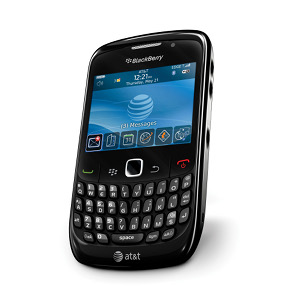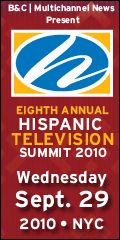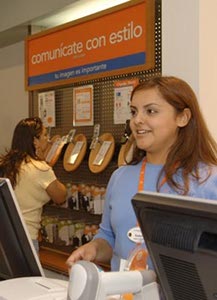Posted by Elena del Valle on August 30, 2010

BlackBerry cell phone
Photos: AT&T, Verizon
An increasing percentage of people in the United States is taking advantage of cell phone and wireless laptop access to the internet. According to the results of a Pew Research Center’s Internet and American Life Project survey released in July 2010, 59 percent of adult respondents said they access the internet with a wireless system through a cell phone or laptop computer. In 2009, 51 percent of survey respondents said they accessed the internet with a wireless system through a cell phone or laptop computer.
In the last year, 47 percent of adults said they went online with a laptop WiFi connection or a mobile broadband card. This represents an increase compared to 39 percent who said they did that in April 2009; 40 percent said they access the internet, email or instant messaging on a mobile phone compared with 32 percent who said they did that in 2009.

Verizon and ZTE USA AD3700 USB modem
People are also using non voice phone applications more than in the past. More people are taking pictures, 76 percent compared to 66 in April 2009; 72 percent send or receive text messages compared to 65 percent in 2009; 38 percent access the internet compared to 25 percent in 2009; 34 percent play games compared to 27 percent in 2009; 34 percent send or receive email compared to 25 percent in 2009; 34 percent said they record a video compared to 19 percent in 2009; 33 percent said they play music compared to 21 percent in 2009; and 30 percent send or receive instant messages compared to 20 percent in 2009.
Contrary to a recent Pew Hispanic Center report that indicated Latinos lag behind in their use of technology compared to the general population (see Latinos lag behind in use of technology compared to non Latinos), in this survey researchers concluded that African-Americans and English-speaking Latinos, remain among the most active users of these technologies. The Pew Hispanic Center report included Spanish dominant Latinos while this one only mentioned English speaking Latinos. More African-Americans and Latinos, 87 percent, own cell phones than whites 80, according to the survey responses.
They also use more of their phone’s features compared with white mobile phone owners. This year more African-Americans (64 percent) said they access the internet from a laptop or mobile phone, compared to 57 percent who said they did in 2009.
“The Hispanic consumer market is one of the fastest growing in the U.S. and is very attractive to wireless providers, not just in terms of growing population but also in terms of usage. Hispanics over-index in almost every category: They use more minutes, they make more long-distance calls, they text more, and they download more ringtones” said Kelly Starling, spokesperson, AT&T.
The report, Mobile Access 2010, released July 7, 2010 is based on the findings of a daily tracking survey on Americans’ use of the internet. The data is from telephone interviews, in English, of 2,252 adults 18 years old and older conducted by Princeton Survey Research Associates International between April 29 and May 30, 2010.
Posted by Elena del Valle on August 27, 2010
By Marga Fournier-Padró

A Death in Dallas book cover
Photos: Ascot Media Group, Inc.
In A Death in Dallas (Publish America, $24.95), a 239-page novel, Ernest E. Hunt addresses the subject of human slavery and drug trafficking, an issue that has existed almost since the beginning of time. Greediness, hunger for power and the weaknesses of many who fall prey to such crimes, leads to exploitation and human slavery. Much has been written and showcased in film about this subject of sex, rape, revenge, crime, drugs and human trafficking.
In A Death in Dallas a young Mexican schoolgirl is kidnapped, along with other students, from a border town in Mexico and smuggled into the United States by degenerates from both sides of the border. Smugglers from other countries down south use the same Mexican routes to take advantage of existing routes and corruption, deriving huge profits from exchanging girls and women for sex, especially the very young. There is also the added attraction and very profitable business of narcotic drugs.
The murder of a man on a street in Dallas left a mystery, a why. Someone phoned the police department to report a crime. When the police arrived they found a body but no witness. Was the deceased placed there to attract someone to shoot at? Did the sniper mean to shoot a policeman who came to investigate the death or simply to scare someone? Did it have anything to do with the kidnapping of the young Mexican girl? The mystery led authorities to discover a smuggling ring of humans and drugs.
The author brings together characters whose life mishaps produce enough adrenaline to cause a reaction between characters and allows them to understand each other’s pain. For some, their own internal crucifixion pushes them in favor of vengeance. For others, justice, duty or anger brings them together to fight and find ways to stop so much hurt and abuse.
The Iraq War leaves a soldier’s face and soul scarred. Mexplotations leaves a group of young girls terrified and scarred because of horrific abuses. The greed for power among members of a well known family who have lost their values and ethics makes some of them indulge in the worst kind of vices for the sake of money to buy their way to congress and for devious fun.

Author Ernest E. Hunt
An Iraq war hero’s somber thoughts make him perform a sniper act that eventually changes his life. The hero meets the heroine in a brothel and together they part in search of justice. The innocence and intelligence of the very young abused heroine draws more characters and drama into the story.
The members of a religious congregation, detectives, police from both sides of the border and even an employee distraught by the meanness of her employer join forces to uncover the source of the sex-drug ring and to entrap those involved, lifting a veil of scandal and corruption.
Although the author explains the horror of human degradation lived by Juanita Delgato, he only touches the tip of a slavery iceberg. In real life, outside of inner vice circles and advocates who fight for these victims, people don’t have the slightest idea of the horror stories lived by children involved in this human racket, be it in Nuevo Laredo, Juárez, Cancún in Mexico or in any city in the United States; activities that should be stopped and penalized everywhere and by all nations.
Fortunately, clean and pure love sprouts among some of the characters to overpower their own sad family love stories. The author’s search for factual sources enhances and adds substance to the book. Some could call it a thriller; however, it is a description of a very sad reality being lived every minute somewhere in the world. Nevertheless, the subtle way, language and sources of justice used by Hunt to vindicate much sorrow in some of the characters involved makes this story worth reading. His descriptive power made me feel like I was traveling along with each character, admiring or disliking the scenery and the story evolution.
According to his biography, Hunt was ordained in the Episcopal Church at Stanford University and was rector of the Church of the Epiphany in Manhattan for 16 years. He spent four years in Saint Matthews and 11 years in Paris, France.
There is no doubt that the author´s background influenced this fictional story, as he describes it, with the credibility of human violations happening every second all over the world. He was able to capture the essence of the problem, ending the story in a language that does not offend, one that can be read by students to open their eyes and make them aware of predators and people with few scruples.

Click here to buy A Death in Dallas
Comments:
Filed Under: Books
Posted by Elena del Valle on August 26, 2010
Information provided by our Event Partner

24th Annual NAMIC Conference – “3D: Diversity, Digital, Demographics”
September 14 -15, 2010
Hilton New York
Presented as part of Diversity Week
Don’t miss the communications industry’s leading diversity symposium! Presented by the National Association for Multi-ethnicity in Communications (NAMIC), the 24th Annual NAMIC Conference “3D: Diversity, Digital, Demographics” will present diversity and inclusion through the 3D, stereoscopic lens of the communications industry’s business operations, expanding distribution platforms, and content development for a culturally complex and globally connected viewership.
We invite professionals at every organizational level to attend this premier educational event where they will interact with leaders at the forefront of innovation; discover new ways to leverage diverse perspectives within their own companies; and receive valuable insights into business and career strategies.
The two-day agenda will focus on Digital Media, Diversity & Inclusion, Leadership Development and Multi-ethnic Content & Programming, as well as “hot topic” sessions such as Hispanic America 2010 presented by The Nielsen Company and the Excellence in Multi-cultural Marketing Awards (EMMA). Special events include the L. Patrick Mellon Mentorship Program Luncheon, Mickey Leland Humanitarian Achievement Award Luncheon, Breakfast Honoring the CableFAX “Most Influential Minorities in Cable,” Diversity in Communications Career Expo and strategic networking opportunities.
Register online at www.namic.com. For more information and sponsorship opportunities, contact NAMIC at 212-594-5985. Group registration discounts are available. Register early and save.
Posted by Elena del Valle on August 25, 2010
By Adrienne E. Katz Katz

Adrienne E. Katz Katz
Mankind has walked on Earth for thousands of years, but women have been allowed to vote for only ninety years! It took 131 years after the U.S. Constitution was adopted before American men grudgingly granted women the right to vote.
Every woman today who has in her own name a job, a bank account, a credit card, a lease, a car, a mortgage, a diploma or a pension has these because she is standing on the shoulders of millions of women who fought for those privileges.
The United States is celebrating Women’s Equality Day on August 26, commemorating the passage of the 19th Amendment to the U.S. Constitution. This amendment gave women the right to vote on this date in 1920.
Click here to read the entire article Look how far we’ve come and how far we still have to go
Posted by Elena del Valle on August 24, 2010
Information provided by our Event Partner

The 8th Annual Hispanic Television Summit
Wednesday, September 29, 2010, Hilton New York Hotel
Special Offer for HispanicMPR.com subscribers
$50 off regular price of $399 until September 1st ($349) &
$100 off regular price of $499 after September 1st ($399)
The 8th Annual Hispanic Television Summit will be held Wednesday, September 29, 2010 at the Hilton New York Hotel. It is presented by Broadcasting & Cable and Multichannel News. Oscar De La Hoya will be honored for A Lifetime of Achievement in Hispanic Television. Confirmed keynote speakers are Ramón Escobar, EVP Telemundo; Diane Jones Lowrey, Director Diversity Marketing & Operations, Levi Strauss & Company; Alita Vegas, Director Multicultural Marketing, P&G. The Summit is the signature conference for executives involved in the business of television and digital video targeted to the US Hispanic and Latin American viewing audience and attended by over 400 key industry executives.
To register, please visit www.broadcastingcable.com/hispanic2010, www.multichannel.com/hispanic2010 or call Sandy Friedman at 646-746-6740.
Posted by Elena del Valle on August 23, 2010

Romano Richetta, senior vice president, Participant Services, TIAA-CREF
Photo: TIAA-CREF
A podcast interview with Romano Richetta, senior vice president, Participant Services, Teachers Insurance and Annuity Association College Retirement Equities Fund (TIAA-CREF) is available in the Podcast Section of Hispanic Marketing & Public Relations, HispanicMPR.com. During the podcast, Romano discusses his company’s Spanish language initiatives to provide United States Latinos access to a secure retirement with Elena del Valle, host of the HispanicMPR.com podcast.
Romano has served as senior vice president of Participant Services at TIAA-CREF since July 2006. He oversees TIAA-CREF’s Call Center and Field Consulting Group with more than 1,400 employees. From November 2001 to May 2006, Romano served as senior vice president at JPMorgan Chase & Co. where he managed the Telephone Channel in the retail bank.
Prior to joining that company he was a senior manager at Deloitte & Touche LLP serving as an operations and strategy consultant. Romano, who holds a Masters degree from Massachusetts Institute of Technology and an MBA from the University of Texas at Austin, is a registered principal and registered representative.
To listen to the interview, scroll down until you see “Podcast” on the right hand side, then select “HMPR Romano Richetta” click on the play button below or download the MP3 file to your iPod or MP3 player to listen on the go, in your car or at home. To download it, click on the arrow of the recording you wish to copy and save it to disk. The podcast will remain listed in the August 2010 section of the podcast archive.
Posted by Elena del Valle on August 20, 2010

The Secret Side of Anger
Placing blame on others for our actions and feelings is a common misconception of where the blame should really be, according to Janet Pfeiffer, author, The Secret Side of Anger (Tate Publishing and Enterprises, LLC, $12.99). She believes that taking responsibility for our own feelings and how we deal with them is empowering and the best approach and that finding inner peace is the ultimate goal.
“Most of us believe that other people or situations have the ability to make us angry. This is a big misconception,” said Pfeiffer. In her book she shares the wisdom about anger she has acquired over the years through personal situations and professional experiences coaching others.
Mixed in with jokes, personal and professional anecdotes and occasional references to God, Pfeiffer presents readers with tips on reducing anger that she says have made her personal and professional life better. In the 190-page book Pfeiffer explains that: thoughts lead to feelings and feelings are our choice; it is up to each person to choose the thoughts and feelings he or she has and how to deal with them; and it is up to each individual to take responsibility for his or her life.
“No individual or event has the power to make you mad. Anger is actually a choice, one that occurs depending on that person’s perception (thought). What we choose to think about an experience we’re having or the person we’re involved with determines how we feel. For instance, if someone criticizes you, you can think ‘She’s so mean!’ Or, you can choose, ‘How unfortunate someone could be so insensitive.’ The former evokes anger, the latter, sadness. The truth behind her actions matters little. You only need to concern yourself with how you choose to perceive her and allow her behavior to affect you.”
Pfeiffer, described in promotional materials as a certified violence counselor and motivational speaker, believes unresolved anger leads to resentment and bitterness and can damage a person’s relationships, health, career, and happiness. She is convinced that feeling anger is not in and of itself bad. What’s important is how people handle the feeling and what they do about it, she says in the book.
She believes that only if mishandled in a destructive or violent way does anger turn negative. She asserts that anger is an important and useful emotion that people can take advantage of to change their lives. An example of positive results that may follow anger is when someone witnesses an injustice in society which fuels his or her anger and eventually leads to the creation of new laws.
Anger, by definition, she says, is a feeling of distress born of feelings of helplessness or powerlessness. When people feel victimized it is because they feel others are controlling them but in reality power and control come from within. Regaining our personal power eliminates feelings of helplessness and anger. Others no longer have the ability to push our buttons and make us mad, she says.
Her tips on reducing anger include: Put everything into perspective. Ask yourself if the situation is worth getting upset about. If not, let it go. If it is important, identify what needs to change and create a plan to accomplish that. Switch your focus (thought) from the problem (negative) to the solution (positive). The moment you feel anger well up inside you, remember SWaT: Stop, Walk and Talk. Stop what you are doing. This prevents the situation from escalating. Next, Walk away. Creating distance allows you to calm down and cool off. “Out of sight, out of mind.”
Third: Talk yourself calm. Discuss your feelings and situation with a neutral party, seeking deeper understanding and guidance. If no one is available, talk to yourself. Repeat calming statements such as “I am fine. I am calm. I can handle this is an intelligent and rational manner.” Create a “Peace Plan”: daily activities to engage in that will naturally reduce your levels of anger. Each of these naturally replaces stress and anger with feelings of peace and serenity. Even a simple act such as deep breathing or smiling will help alleviate anger, she believes.
Pfeiffer, president and chief executive officer, Pfeiffer Power Seminars, LLC, is a motivational speaker, an instructor at a battered women’s shelter, personal coach, columnist, and founder of The Antidote to Anger support group.

Click here to buy The Secret Side of Anger
Comments:
Filed Under: Books
Posted by Elena del Valle on August 19, 2010
We recently found out by a comment from an audience member and then an email reply to Harald Vogt’s email address of his passing. The email said, “Caroline Pieper-Vogt and the family of Harald Vogt regret to inform you of Harald’s recent passing. All Scent Marketing Institute projects, newsletters and events are on hold until further information is available. The Vogt family thanks all for their help and support.” Although a phone call was unanswered we confirmed the news online at Tributes.com, http://www.tributes.com/show/Harald-Vogt-89044965
Earlier this year Harald contributed two Guest Articles to HispanicMPR. In addition HispanicMPR is a Media Partner to The Scent Marketing Institute’s Scent World 2010 event November 17-19, 2010 on Miami Beach, Florida. We extend our condolences to his family and friends.
Posted by Elena del Valle on August 18, 2010

Spanish language signage at a cell phone store
Photos: AT&T, Sony
A bird’s eye view of Latinos across the country reveals lower use of technology than that of non Latinos. Also, age and language preference are indicators of technology use. Older Latinos rely on technology less than young ones. Spanish dominant Latinos use of technology is lower than that of English dominant and bilingual Latinos.
More than two thirds (78 percent) of non Latino adults (18 and older) go online compared to 64 percent of Latinos of the same age; and 86 percent of non Latinos use cell phones while 76 percent of Latinos use cell phones.
At the same time, when it comes to the use of technology not all Latinos are equal. United States born Latinos use of the internet and cell phones is higher than that of foreign born Latinos. Latinos born in the United States are much more likely to use technology, especially the internet, than foreign born Latinos, according to a Pew Hispanic Center report released recently. The report, written by Gretchen Livingston, senior researcher, Pew Hispanic Center points to a significant difference between the two groups. The Pew Hispanic Center is a research organization that seeks to improve understanding of the U.S. Hispanic population.
For example, 85 percent of Latinos 16 and older born in the United States rely on the internet while only 51 percent of their foreign born counterparts surf the digital world. When it comes to cell phone use the difference is less marked: 80 percent of United States born Latinos use a cell phone while 72 percent of foreign born Latinos do so.

Sony Vaio J computer
If we look at technology use among young people in the United States the difference is also clear. Nearly all (96 percent) non Hispanic youth between 18 to 25 years of age surf the internet while only 77 percent of Hispanics go online. Eighty-two percent of non-Hispanics ages 16 and 17 use a cell phone while 72 percent of Hispanics of that age do so. Ninety-four percent of non Hispanics aged between 18 and 25 use a cell phone compared with eighty percent of Hispanics.
If we look at technology use among people 55 and older, there is still a difference between Latinos and non Latinos. Among non Latinos 75 percent use cell phones and 57 percent use the internet while only 60 percent of Latinos in that age group use cell phones and 42 percent use the internet.
When it comes to going online language preference is a key factor. A majority of English dominant (87 percent) Hispanics 16 and older and bilingual (77 percent) Hispanics are more likely to use cell phones than Spanish dominant Latinos (35 percent).
This report was based primarily on the 2009 National Survey of Latinos, conducted from August 5 through September 16, 2009 among a randomly selected, nationally representative sample of 2,012 Hispanics ages 16 and older. The survey was conducted in English and Spanish on landline and cellular phones.
Posted by Elena del Valle on August 17, 2010
WiredLatinos Directory, owned by Mygritomedia LLC, a new online directory offering paid and free listings, added HispanicMPR.com to its directory. WiredLatinosDirectory.com was launched by WiredLatinos.com.
According to the website, the directory is edited by humans. Company executives hope to compile “the most comprehensive list of Latino owned, managed, targeted and community serving websites.” See the HispanicMPR.com listing at http://www.wiredlatinosdirectory.com/hispanicmpr-com/























